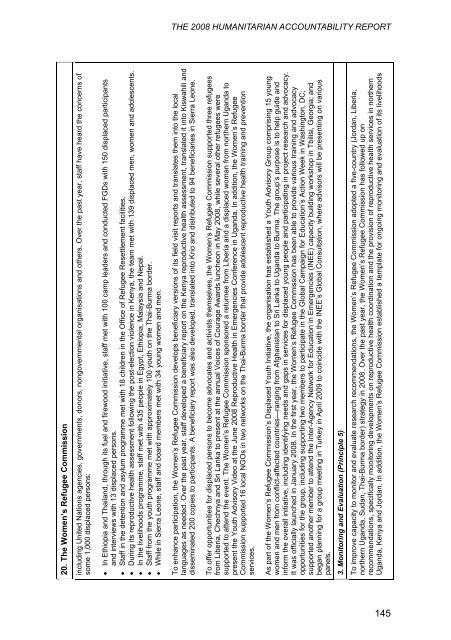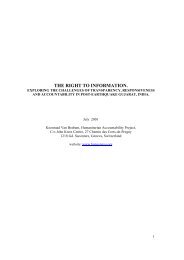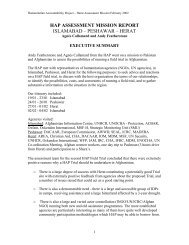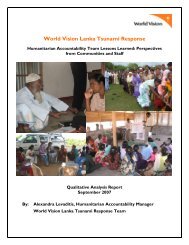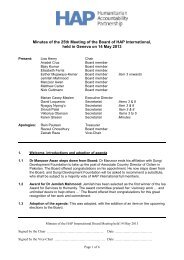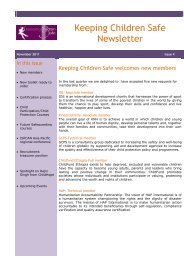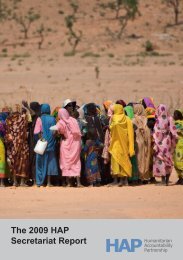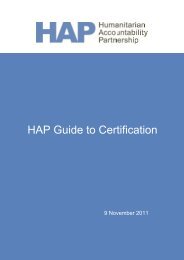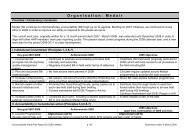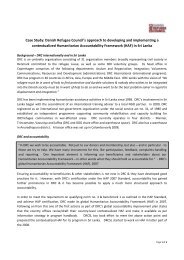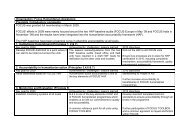Chapter Four - HAP International
Chapter Four - HAP International
Chapter Four - HAP International
You also want an ePaper? Increase the reach of your titles
YUMPU automatically turns print PDFs into web optimized ePapers that Google loves.
THE 2008 HUMANITARIAN ACCOUNTABILITY REPORT<br />
20. The Women’s Refugee Commission<br />
including United Nations agencies, governments, donors, nongovernmental organisations and others. Over the past year, staff have heard the concerns of<br />
some 1,000 displaced persons:<br />
• In Ethiopia and Thailand, through its fuel and firewood initiative, staff met with 100 camp leaders and conducted FGDs with 150 displaced participants<br />
and interviews with 13 displaced persons.<br />
• Staff in the detention and asylum programme met with 18 children in the Office of Refugee Resettlement facilities.<br />
• During its reproductive health assessment following the post-election violence in Kenya, the team met with 139 displaced men, women and adolescents.<br />
• In the livelihoods programme, staff met with 435 people in Egypt, Ethiopia, Malaysia and Nepal.<br />
• Staff from the youth programme met with approximately 100 youth on the Thai-Burma border.<br />
• While in Sierra Leone, staff and board members met with 34 young women and men.<br />
To enhance participation, the Women’s Refugee Commission develops beneficiary versions of its field visit reports and translates them into the local<br />
languages as needed. Over the past year, staff developed a beneficiary report on the Kenya reproductive health assessment, translated it into Kiswahili and<br />
disseminated 200 copies to participants. A beneficiary report was also developed, translated into Krio and distributed to 94 beneficiaries in Sierra Leone.<br />
To offer opportunities for displaced persons to become advocates and activists themselves, the Women’s Refugee Commission supported three refugees<br />
from Liberia, Chechnya and Sri Lanka to present at the annual Voices of Courage Awards luncheon in May 2008, while several other refugees were<br />
supported to attend the event. The Women’s Refugee Commission sponsored a returnee from Liberia and a displaced woman from northern Uganda to<br />
present the Youth Advisory Video at the June 2008 Reproductive Health in Emergencies Conference in Uganda. In addition, the Women’s Refugee<br />
Commission supported 16 local NGOs in two networks on the Thai-Burma border that provide adolescent reproductive health training and prevention<br />
services.<br />
As part of the Women’s Refugee Commission’s Displaced Youth Initiative, the organisation has established a Youth Advisory Group comprising 15 young<br />
women and men from conflict-affected countries—ranging from Afghanistan to Sri Lanka to Uganda to Burma. The group’s purpose is to help guide and<br />
inform the overall initiative, including identifying needs and gaps in services for displaced young people and participating in project research and advocacy.<br />
It was officially launched in January 2008. In the first year, the Women’s Refugee Commission has been able to provide various training and advocacy<br />
opportunities for the group, including supporting two members to participate in the Global Campaign for Education’s Action Week in Washington, DC;<br />
supported another member to attend the Inter-Agency Network for Education in Emergencies (INEE) capacity building workshop in Tbilisi, Georgia; and<br />
began planning for a group meeting in Turkey in April 2009 to coincide with the INEE’s Global Consultation, where advisors will be presenting on various<br />
panels.<br />
3. Monitoring and Evaluation (Principle 5)<br />
To improve capacity to monitor and evaluate research recommendations, the Women’s Refugee Commission adopted a five-country (Jordan, Liberia,<br />
northern Uganda, Sudan, Thai-Burma border) strategy in 2008. Over the past year, the Women’s Refugee Commission has followed up on<br />
recommendations, specifically monitoring developments on reproductive health coordination and the provision of reproductive health services in northern<br />
Uganda, Kenya and Jordan. In addition, the Women’s Refugee Commission established a template for ongoing monitoring and evaluation of its livelihoods<br />
120<br />
145


